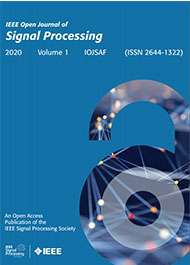- Our Story
- Publications & Resources
- Publications & Resources
- Publications
- IEEE Signal Processing Magazine
- IEEE Journal of Selected Topics in Signal Processing
- IEEE Signal Processing Letters
- IEEE Transactions on Computational Imaging
- IEEE Transactions on Image Processing
- IEEE Transactions on Information Forensics and Security
- IEEE Transactions on Multimedia
- IEEE Transactions on Signal and Information Processing over Networks
- IEEE Transactions on Signal Processing
- IEEE TCI
- IEEE TSIPN
- Data & Challenges
- Submit Manuscript
- Guidelines
- Information for Authors
- Special Issue Deadlines
- Overview Articles
- Top Accessed Articles
- SPS Newsletter
- SigPort
- SPS Resource Center
- Publications FAQ
- Blog
- News
- Dataset Papers
- Conferences & Events
- Community & Involvement
- Professional Development
- For Volunteers
- Information for Authors-OJSP
-
Home
Conferences Events IEEE Signal Processing Magazine IEEE SPL Article IEEE TIFS Article IEEE TMM Article IEEE TSP Article Jobs in Signal Processing Lectures Machine Learning Seasonal Schools Signal Processing News SPM Article SPS Distinguished Lectures SPS Newsletter Article SPS Webinar SPS Webinars SPS Webinar Series Webinar webinars
-
Our Story
What is Signal Processing?

The technology we use, and even rely on, in our everyday lives –computers, radios, video, cell phones – is enabled by signal processing. Learn More » -
Publications & Resources
-
SPS Resources
- Signal Processing Magazine The premier publication of the society.
- SPS Newsletter Monthly updates in Signal Processing
- SPS Resource Center Online library of tutorials, lectures, and presentations.
- SigPort Online repository for reports, papers, and more.
- SPS Feed The latest news, events, and more from the world of Signal Processing.
-
SPS Resources
-
Conferences & Events
-
Community & Involvement
-
Membership
- Join SPS The IEEE Signal Processing Magazine, Conference, Discounts, Awards, Collaborations, and more!
- Chapter Locator Find your local chapter and connect with fellow industry professionals, academics and students
- Women in Signal Processing Networking and engagement opportunities for women across signal processing disciplines
- Students Scholarships, conference discounts, travel grants, SP Cup, VIP Cup, 5-MICC
- Young Professionals Career development opportunities, networking
- Get Involved
-
Technical Committees
- Applied Signal Processing Systems
- Audio and Acoustic Signal Processing
- Bio Imaging and Signal Processing
- Computational Imaging
- Image Video and Multidimensional Signal Processing
- Information Forensics and Security
- Machine Learning for Signal Processing
- Multimedia Signal Processing
- Sensor Array and Multichannel
- Signal Processing for Communication and Networking
- Signal Processing Theory and Methods
- Speech and Language Processing
- Technical Working Groups
- More TC Resources
-
Membership
-
Professional Development
-
Professional Development
- Signal Processing Mentorship Academy (SigMA) Program
- Micro Mentoring Experience Program (MiME)
- Distinguished Lecturer Program
- Distinguished Lecturers
- Distinguished Lecturer Nominations
- Past Lecturers
- Distinguished Industry Speaker Program
- Distinguished Industry Speakers
- Distinguished Industry Speaker Nominations
- Industry Resources
- IEEE Training Materials
- Jobs in Signal Processing: IEEE Job Site
-
Career Resources
- SPS Education Program Educational content in signal processing and related fields.
- Distinguished Lecturer Program Chapters have access to educators and authors in the fields of Signal Processing
- Job Opportunities Signal Processing and Technical Committee specific job opportunities
- Job Submission Form Employers may submit opportunities in the area of Signal Processing.
-
Professional Development
-
For Volunteers
-
For Board & Committee Members
- Board Agenda/Minutes* Agendas, minutes and supporting documentation for Board and Committee Members
- SPS Directory* Directory of volunteers, society and division directory for Board and Committee Members.
- Membership Development Reports* Insight into the Society’s month-over-month and year-over-year growths and declines for Board and Committee Members
-
For Board & Committee Members
Popular Pages
Today's:
- (IVMSP 2026) IEEE 15th Image, Video, and Multidimensional Signal Processing Workshop
- Information for Authors
- SPS BSI Webinar: Integration of Brain Imaging and Genomics with Interpretable Multimodal Collaborative Learning
- IEEE Transactions on Information Forensics and Security
- IEEE Transactions on Image Processing
- (ICME 2026) 2026 IEEE International Conference on Multimedia and Expo
- IEEE Transactions on Multimedia
- IEEE Signal Processing Letters
- IEEE Transactions on Audio, Speech and Language Processing
- Conference Call for Papers
- Submit a Manuscript
- Access Restricted
- Publications & Resources
- Unified EDICS
- (CAI 2026) IEEE Conference on Artificial Intelligence 2026
All time:
- Information for Authors
- Submit a Manuscript
- IEEE Transactions on Image Processing
- IEEE Transactions on Information Forensics and Security
- IEEE Transactions on Multimedia
- IEEE Transactions on Audio, Speech and Language Processing
- IEEE Signal Processing Letters
- IEEE Transactions on Signal Processing
- Conferences & Events
- IEEE Journal of Selected Topics in Signal Processing
- Information for Authors-SPL
- Conference Call for Papers
- Signal Processing 101
- IEEE Signal Processing Magazine
- Guidelines
Last viewed:
- IEEE Signal Processing Letters
- IEEE Transactions on Audio, Speech and Language Processing
- Fang Lu (Hong Kong University of Science and Technology), “Digital Image and Video Processing Using Subpixel Rendering” (2011)
- New Journal - IEEE Transactions on Computational Imaging (TCI)!
- (IVMSP 2026) IEEE 15th Image, Video, and Multidimensional Signal Processing Workshop
- Collaborative Cloud and Edge Mobile Computing in C-RAN Systems
- Information for Authors
- About Transactions on Information Forensics and Security
- SPS Staff
- SPS Pioneers in IEEE History: Member Highlight: Dr. Sanjit K. Mitra Elected to the Engineering Academy of Japan
- Guidelines
- Chapter Certification
- An Efficient Forecasting Approach to Reduce Boundary Effects in Real-Time Time-Frequency Analysis
- Upcoming Distinguished Lectures
- Chapter Chair Meetings
Per-Wavelet Equalization for Discrete Wavelet Transform Based Multi-Carrier Modulation Systems
You are here
Open Journal of Signal Processing
Publications & Resources
For Authors
Top Reasons to Join SPS Today!
1. IEEE Signal Processing Magazine
2. Signal Processing Digital Library*
3. Inside Signal Processing Newsletter
4. SPS Resource Center
5. Career advancement & recognition
6. Discounts on conferences and publications
7. Professional networking
8. Communities for students, young professionals, and women
9. Volunteer opportunities
10. Coming soon! PDH/CEU credits
Click here to learn more.
Per-Wavelet Equalization for Discrete Wavelet Transform Based Multi-Carrier Modulation Systems
The Discrete Wavelet Transform (DWT) has gained attention in the area of Multi-Carrier Modulation (MCM) because it can overcome some well known limitations of Discrete Fourier Transform (DFT) based MCM systems. Its improved spectral containment removes the need for a cyclic prefix, be it that appropriate equalization then has to be added as the cyclic convolution property no longer holds. Most DWT based MCM systems in the literature use Time-domain EQualizers (TEQs) to mitigate the channel distortion. In this paper, a Per-Wavelet EQualizer (PWEQ) is proposed which directly maximizes the Signal-to-Interference-plus-Noise Ratio (SINR) per symbol and is applicable to any wavelet family. The proposed PWEQ provides a performance upper bound for the TEQs for DWT based MCM systems. The computational complexity of the PWEQ is reduced by modifying the Filter Bank (FB) structure of the DWT. Simulations are performed to compare the PWEQ performance against the TEQs for DWT based MCM systems and the similar Per-Tone EQualizer (PTEQ) for DFT based MCM systems. The simulations are performed using measured Asymmetric Digital Subscriber Line (ADSL) and G.fast channels with Fejér-Korovkin (FK) wavelets. The proposed PWEQ increases the SINR on the received symbols compared to the TEQs at the cost of an increased computational complexity.
Introduction
Discrete Multi-Tone (DMT) modulation has dominated broadband wireline [1], [2], [3], [4] and wireless [5], [6] communications over the last decades. It is a Discrete Fourier Transform (DFT) based Multi-Carrier Modulation (MCM) system with a fairly simple receiver structure where, because of the use of an appropriately long cyclic prefix, channel equalization can be done with a single-tap filter per tone, i.e. one complex multiplication per tone. However, the cyclic prefix length
SPS Social Media
- IEEE SPS Facebook Page https://www.facebook.com/ieeeSPS
- IEEE SPS X Page https://x.com/IEEEsps
- IEEE SPS Instagram Page https://www.instagram.com/ieeesps/?hl=en
- IEEE SPS LinkedIn Page https://www.linkedin.com/company/ieeesps/
- IEEE SPS YouTube Channel https://www.youtube.com/ieeeSPS
Home | Sitemap | Contact | Accessibility | Nondiscrimination Policy | IEEE Ethics Reporting | IEEE Privacy Policy | Terms | Feedback
© Copyright 2025 IEEE - All rights reserved. Use of this website signifies your agreement to the IEEE Terms and Conditions.
A public charity, IEEE is the world's largest technical professional organization dedicated to advancing technology for the benefit of humanity.











